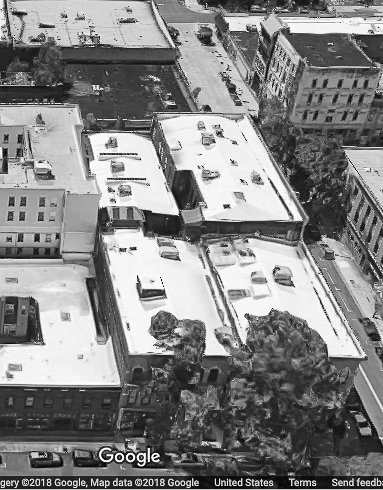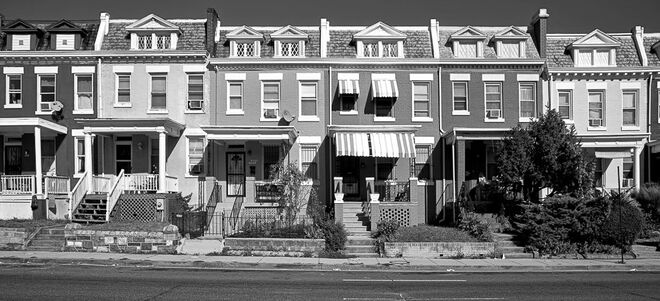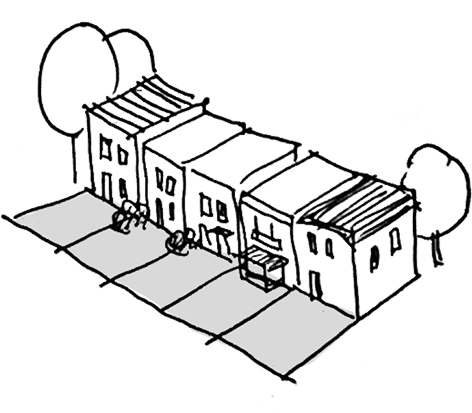7.3. Small plots
Aus Pattern Language Wiki
(Weitergeleitet von .../Small plots)
Within a Perimeter Block, it is important to keep a variety of scales of buildings.
Problem-statement: Large plots are more expensive, and tend to attract a more limited pool of users. A mix of small plot sizes helps to keep spaces more affordable, and promotes greater diversity of business types and characteristics.
Discussion: The evidence for this pattern is easy to see in examples where plot sizes are universally large. The buildings on these plots are also generally very large, often with large users as well. Even in the case of smaller “demised” lease spaces with in a larger building (such as a “strip” shopping center) there is often a homogeneity of “chain” type businesses.
There is a place for some large plot sizes as well, particularly if they are “demised” into smaller retail and residential spaces (e.g. in condominiums, or smaller rental stalls). But there is an advantage in having a mix of individually-owned plots, each of which is able to grow and adapt according to its owner’s individual needs. (Demising means to separate spaces according to individual tenants and uses, and includes erecting partitions and party walls.)
Another supporting rationale comes from optimizing the pedestrian urban space of the street, which is necessary for urban vitality. It is far easier to achieve the design variety and spatial rhythm necessary for a positive urban experience if the plot sizes are small, and individual agents are working on a variety of different projects and scales (but within an overriding code or coordinating plan). Unfortunately, there are many examples where unfriendly façades made possible by large plot size has ruined a street, so that no one wants to walk along it.
Having control of the entire street length, when combined with a preference for minimalist walls, tends to generate unfriendly surfaces made even more oppressive because of their length.
Therefore:
Lay out plots with the fundamental unit quite small, perhaps no wider than 6 meters or 20 feet. Include a mix of sizes, with some larger plots depending on market conditions.
Use the Row Building pattern at the edges, and maintain Layered Zones with Place Network. …
¹ Our colleague Sergio Porta and his associates have done some of the most relevant work for this pattern — see e.g. Porta, S., & Romice, O. (2014). Plot-based urbanism: Towards time-consciousness in place-making. In Dortmunder Vorträge zur Stadtbaukunst [Dortmunder Lectures on Civic Art]: New Civic Art (pp. 82-111). Dortmund DE: Deutsches Institut für Stadtbaukunst.
Mehaffy, M. et al. (2020). SMALL PLOTS (pattern). In A New Pattern Language for Growing Regions. The Dalles: Sustasis Press. Available at https://pattern-language.wiki/.../Small_plots
SECTION I:
PATTERNS OF SCALE
1. REGIONAL PATTERNS
Define the large-scale spatial organization…
1.4. 400M THROUGH STREET NETWORK
2. URBAN PATTERNS
Establish essential urban characteristics…
3. STREET PATTERNS
Identify and allocate street types…
4. NEIGHBORHOOD PATTERNS
Define neighborhood-scale elements…
5. SPECIAL USE PATTERNS
Integrate unique urban elements with care…
6. PUBLIC SPACE PATTERNS
Establish the character of the crucial public realm…
7. BLOCK AND PLOT PATTERNS
Lay out the detailed structure of property lines…
8. STREETSCAPE PATTERNS
Configure the street as a welcoming place…
9. BUILDING PATTERNS
Lay out appropriate urban buildings…
10. BUILDING EDGE PATTERNS
Create interior and exterior connectivity…
10.1. INDOOR-OUTDOOR AMBIGUITY
SECTION II:
PATTERNS OF MULTIPLE SCALE
11. GEOMETRIC PATTERNS
Build in coherent geometries at all scales…
11.2. SMALL GROUPS OF ELEMENTS
12. AFFORDANCE PATTERNS
Build in user capacity to shape the environment…
13. RETROFIT PATTERNS
Revitalize and improve existing urban assets …
14. INFORMAL GROWTH PATTERNS
Accommodate “bottom-up” urban growth…
15. CONSTRUCTION PATTERNS
Use the building process to enrich the result…
SECTION III:
PATTERNS OF PROCESS
16. IMPLEMENTATION TOOL PATTERNS
Use tools to achieve successful results…
16.2. ENTITLEMENT STREAMLINING
16.3. NEIGHBORHOOD PLANNING CENTER
17. PROJECT ECONOMICS PATTERNS
Create flows of money that support urban quality…
17.4. ECONOMIES OF PLACE AND DIFFERENTIATION
18. PLACE GOVERNANCE PATTERNS
Processes for making and managing places…
18.3. PUBLIC-PRIVATE PLACE MANAGEMENT
19. AFFORDABILITY PATTERNS
Build in affordability for all incomes…
19.1. INTEGRATED AFFORDABILITY
20. NEW TECHNOLOGY PATTERNS
Integrate new systems without damaging old ones…
20.2. RESPONSIVE TRANSPORTATION NETWORK COMPANY


